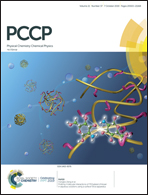Cation⋯cation hydrogen bonds in synephrine salts: a typical interaction in an unusual environment†
Abstract
Hydrogen bonds between the same charge species have been labelled sometimes as pseudo, destabilizing or anti-electrostatic types as they fail to overcome the energetic destabilization, resulting from electrostatic repulsion between same charged species. They have also been proposed to be a result of coulombic compression caused by the attraction between counterions in the crystals. Such a hypothesis is faulty, which undermines the importance of hydrogen bonds in these cases. In this context, we report several cation⋯cation species held together by the O–H⋯O, N–H⋯O and C–H⋯O type hydrogen bonds observed in the crystalline salts of a nutraceutical compound (±)-p-synephrine. The hydrogen-bonded cation⋯cation molecular pairs present in these salts were carefully analyzed using the quantum theory of atoms in molecules, non-covalent interaction plots, potential energy surface scans, and energy decomposition analysis. This study provides new insights into the nature and strength of the various types of hydrogen bonds present between the cationic molecular pairs and helps in delineating the role played by them in stabilizing the cation⋯cation assembly. We also report a unique cationic dimer having water-mediated N–H⋯O hydrogen bonds, which hold the two cationic charge centres at a very short intermolecular distance in the crystal. The analysis of the water-mediated cationic pair observed in this case revealed that the solvent can play a crucial role in reducing the coulombic repulsion between the two cations.



 Please wait while we load your content...
Please wait while we load your content...